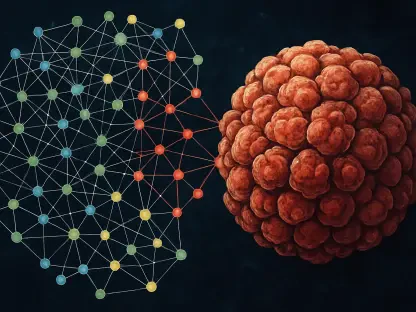Synthetic biology stands at the forefront of modern science, with gene therapy being one of its most exciting horizons. The ability to control gene expression within mammalian cells holds enormous potential for treating a myriad of diseases. However, achieving precise and robust inducible gene expression has remained a significant challenge. Current methodologies often fall short, either leading to so-called “leaky” expression where the gene is partially active even when not desired, or struggle to achieve a high level of expression when triggered. A synthetic gene circuit offers a promising solution, yet the limitations of existing technologies have called for more sophisticated approaches.The concept of a synthetic gene circuit is not new, but its application within the field of gene therapy demands innovative enhancements for effective treatment avenues. These circuits, akin to carefully designed electrical systems, control how and when genes are turned on or off. However, traditional circuits often face the shortcoming of either incomplete suppression of gene activity or lackluster activation, striking a challenging balance to obtain high fold induction—the ratio of maximum to basal expression level.
Engineering the CASwitch System
Understanding Traditional Gene Circuits
Gene regulation technologies, such as the Tet-On3G system, have pioneered the way for controllable gene expression by utilizing tetracycline for transcription activation. These systems are highly innovative but face challenges, notably the issue of “leaky” expression, which can lead to gene activity even when it should be completely shut off. This can be problematic, especially when precision and tight control over gene expression are critical, such as in therapeutic contexts where dosage and timing are paramount.To overcome these hurdles, ongoing research is focused on enhancing the fidelity of these inducible systems. The goal is twofold: to achieve a state of absolute silence in the off-state, and to enable robust expression upon induction. This balance is essential to ensure that therapeutic genes are only active at the right time and at the proper levels, avoiding unintended consequences that could arise from premature or excessive gene activity.By refining the Tet-On and similar systems to address these specific limitations, scientists are aiming to bring gene regulation technologies to a new level of precision. The improvements are anticipated to significantly impact gene therapy and other applications where the slightest deviation in gene expression can have profound effects. These advances underscore the importance of precision in the development of inducible expression systems and their potential for expanding the horizons of genetic medicine and research.
The Novel Coherent Inhibitory Loop (CIL) Circuit
The emergence of the Coherent Inhibitory Loop (CIL) circuit represents a significant leap in gene regulatory networks, combining the Coherent Feed-Forward Loop and Mutual Inhibition motifs. This advanced design incorporates the precision of CRISPR-CasRx endoribonuclease technology with the dynamic Tet-On3G system. An impressive aspect of the CIL is its ability to finely tune gene expression, reducing unintended basal expression while maintaining the potential for robust induction when needed. This careful balance is pivotal for gene therapy applications, where precise control over gene activation is critical. The CIL circuit’s integration of two powerful gene regulation motifs along with cutting-edge tools positions it as a superior alternative to older systems, potentially revolutionizing the efficiency and safety of gene therapy strategies.
Computational Modelling and Experimental Validation
Designing the Synthetic Circuit Topologies
Creating math-based models is a critical step for comparing different synthetic gene circuit designs like the Coherent Feedforward Loop type 4 (CFL type 4), Mutual Inhibition (MI), and a promising newcomer, the Coherent Inhibitory Loop (CIL). Computational biology analyses have pointed to the possibility that the CIL configuration may outperform others. It shows potential for minimizing unintended gene expression, known as leakage, while also ensuring a high level of intentional gene expression.This theoretical advantage of the CIL has made it a keen area of focus. The findings from the mathematical simulations suggest that the CIL could be more efficient in gene regulation, striking a balance between suppressing accidental activation of genes and allowing for strong expression when needed.These insights gained from computational models are guiding scientific experiments. Researchers are now looking to conduct empirical studies to verify these predictions about the CIL’s performance. If laboratory tests confirm the model’s results, the CIL could become a favored design in the development of synthetic gene circuits, with significant implications for the field of synthetic biology. This could lead to more precise control mechanisms in genetic engineering, aiding in advancements in everything from medicine to environmental sustainability.
Lab Validation Using Mammalian Cell Lines
In a controlled laboratory environment, a team of researchers tested the performance of the CIL circuit using HEK293T cells, a type of mammalian cell. Their goal was to evaluate CIL’s effectiveness in gene regulation based on computer-based predictions. The findings from these experiments were positive and revealed that CIL successfully managed to minimize unintended gene expression, known as “leakiness,” while also retaining its ability to be induced when required. These outcomes were in line with the prior in silico forecasts and demonstrated that the CIL system might indeed offer a promising approach for managing gene expression in mammalian cells. As predicted, the CIL circuit exhibited a strong balance between suppression of background activity and activation upon demand, establishing its potential for use in complex biological systems. The verification of these characteristics suggests that CIL circuits have the capacity to become an integral tool in the advancement of synthetic biology and therapeutic applications where precise cellular control is paramount. Further research and development could lead to CIL circuits playing a pivotal role in the fine-tuning of gene therapies, advancing the quest for more targeted and effective treatments.
Applications of the CASwitch System
Enhancing Intracellular Biosensors
Consider a biosensor revolutionized by the integration of a system known as CASwitch, whose original design was to monitor copper levels. This fusion has not only stretched the dynamic range of the biosensor to remarkable new widths but has also significantly sharpened its perceptive capabilities. Minute fluctuations within the cellular milieu, once undetectable, are now within the grasp of this enhanced tool.The CASwitch mechanism brings to the table amplified sensitivity and specificity, transforming the biosensor into an exceedingly precise monitor for cellular changes. This is not just a speculative advancement; the incorporation of CASwitch propels the biosensor’s functionality into a new era of measurement, where subtle biochemical shifts do not go unnoticed. Researchers and clinicians could rely on this profound accuracy for deeper insights into cellular processes or for detecting elusive biomarkers indicative of disease states.In essence, the role of CASwitch in augmenting the biosensor’s performance is akin to refining the lens of a powerful microscope. With this advancement, the biosensor’s response curve is not just broadened—it is redefined, allowing for detection ranges that were previously unattainable. The influence of improved biosensors augmented by systems like CASwitch stretches across multiple domains, offering a window into the complex inner workings of cells with previously unattainable clarity.
Safe Expression of Toxic Genes
The innovative CASwitch system has demonstrated remarkable efficiency in regulating gene activities that could be potentially harmful. One key example of its prowess was observed during experiments involving the Herpes Simplex Virus Thymidine Kinase-1 (HSV-TK1) gene and its interaction with the drug ganciclovir. The CASwitch’s ability to finely tune gene expression was put under scrutiny, and the results were impressive. In the absence of a specific triggering molecule, the system successfully maintained a state where it prevented the HSV-TK1 gene from causing cellular damage. This gene, in the presence of ganciclovir, can lead to cell death, which poses a significant challenge in therapeutic applications.This experiment underscores the potential of the CASwitch methodology to be utilized in scenarios where control over cytotoxic genes is paramount to ensure safety and efficacy. The mechanisms at play allow for precise activation or deactivation of gene expression, which is essential when handling genes with toxic potential. By providing a safety switch that operates only with an external inducer, the system holds great promise for future applications in gene therapy and other biomedical fields where it is crucial to mitigate risks associated with gene expression. The ability to manipulate genetic activity with such specificity heralds a new era in the controlled application of gene-editing technologies.
CASwitch in Gene Therapy Applications
Advancements in AAV Vector Production
Gene therapy heavily relies on the utilization of Adeno-Associated Virus (AAV) vectors, which carry therapeutic genes into patient cells. Though effective, the production of these vectors faces efficiency obstacles. The development of the sophisticated CASwitch v.2 system marked a significant advancement in this field. Experimental outcomes displayed a notable reduction in AAV vector production when the inducer was not present. This highlights the system’s inherent control mechanisms, which allow production to be toggled on only when necessary. By enabling the selective production of vectors, the CASwitch v.2 system enhances the production efficiency, curtails unnecessary resource expenditure, and boosts overall yields. Thus, the gene therapy industry benefits from a more streamlined and economical approach to vector manufacturing, positively impacting the scalability and accessibility of gene therapies.
Potential for Scaling and Safety Improvements
The burgeoning field of gene therapy necessitates systems that can smoothly transition to larger-scale production without compromising on safety. The emergence of the CASwitch system represents a pivotal advancement in the production of adeno-associated virus (AAV) vectors, which are essential tools in gene therapy. This innovative system promises to bridge the gap between the demand for increased scale and the stringent safety requirements inherent to the therapeutic application of genetic engineering.As gene therapy continues to grow and evolve, the need to produce AAV vectors efficiently and safely becomes increasingly critical. The CASwitch system is at the forefront of addressing this challenge, potentially revolutionizing the way AAV vectors are manufactured. By offering a method that scales up production while simultaneously bolstering safety protocols, this system could be a game-changer. Meeting the dual demands for volume and safety is key to the future success of gene therapies and their ability to treat a wide array of genetic conditions.Overall, the CASwitch system symbolizes a significant step forward in gene therapy production. It is designed to keep pace with the expanding scope of gene therapy applications while making no compromises on the safety of the processes. This balance of scalability with safety underscores a major innovation in gene therapy vector manufacturing, indicating a momentous shift towards more accessible and reliable therapeutic interventions.
Synthesizing Insights for Future Developments
Recognizing the Impact of the CASwitch System
The CASwitch system represents a significant innovation in gene expression regulation, effectively addressing the challenge of ‘leakiness’—unwanted activation of gene expression in gene therapy. What makes it stand out is its ability to fine-tune gene activation levels while maintaining the potential for high expression when required. As it overcomes longstanding hurdles associated with gene expression control, the CASwitch system is seen as a transformational tool that could lead to groundbreaking advancements in gene therapy treatments.This new technology promises more precise and reliable control over therapeutic genes, heralding a future where gene therapy is safer and more effective. Its sophisticated mechanism of action minimizes unintended expression, suggesting a higher level of safety and efficiency for future therapies. By ensuring that genes are turned on only when necessary and to the proper extent, the CASwitch system could enable therapies for a myriad of medical conditions that were previously difficult to tackle.In sum, the CASwitch system is poised to reshape the landscape of gene therapy by offering a solution that balances the need for tight regulation of gene expression with the capability of achieving strong activation when needed. Its potential impact on patient care in a range of disorders is immense, ushering in an era of more personalized, controlled, and effective genetic treatments.
Advancing Mammalian Synthetic Biology
The burgeoning field of mammalian synthetic biology brims with anticipation due to emerging innovations like the CASwitch system, which promises to transform gene regulation. Pioneering systems like CASwitch are poised to become the new paradigm in this arena, influencing and advancing a range of scientific disciplines. As the field advances, such systems are expected to lead to groundbreaking applications and are set to redefine our approach to mammalian biological complexities.This shift, driven by technological breakthroughs, harbors the potential to unlock novel solutions for intricate biological puzzles, signaling a significant leap in how scientists can manipulate biological systems with precision. As researchers continue to harness the capabilities of tools like CASwitch, the implications are vast, suggesting a future where synthetic biology integrates seamlessly with and enhances our understanding of biological frameworks. The excitement is tangible among scientists who envision a horizon filled with unbounded possibilities for innovation in mammalian systems, powered by such sophisticated gene regulation systems.









